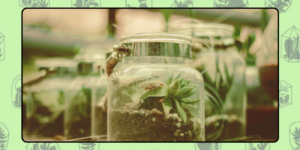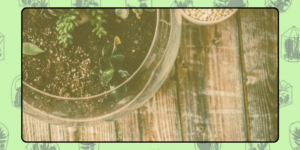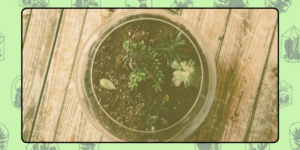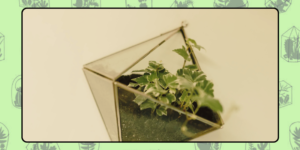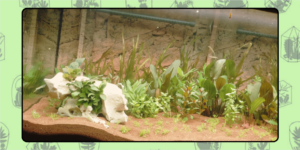HousePlantJoy is supported by our audience. When you purchase through one of our links, we may earn a small affiliate commission. As an Amazon Associate I earn from qualifying purchases. Your cost is not affected.
==================
Terrarium gardens combine creativity and botany, enabling you to create self-sustaining ecosystems in glass containers. Ideal for both avid gardeners seeking a new project and those wanting greenery in small spaces, terrariums offer aesthetic pleasure and the fulfillment of nurturing a miniature world. Understanding terrarium ecosystems and plant care allows you to build a low-maintenance, thriving environment. Enjoy reading!
Terrarium Gardens: Designing and Maintaining Miniature Ecosystems for Beginners
Designing your terrarium involves choosing the right container, selecting plants suited to the closed environment, and layering substrates to replicate natural soil conditions. Maintenance is key to ensuring the longevity of your terrarium garden, involving regular checks on moisture levels, pruning, and troubleshooting common issues. With the right approach, your terrarium can not only become a beautiful focal point in your home but can also serve as an educational tool or a means to therapeutic benefits.
Key Takeaways
- Terrariums merge horticulture with artistic design, fostering a manageable, enclosed habitat for plants.
- Proper layering of substrates and discerning plant selection are central to creating a balanced terrarium.
- Consistent maintenance is essential to sustain these miniature ecosystems’ health and aesthetic appeal.
Understanding Terrarium Ecosystems
A terrarium ecosystem is a self-contained living garden within a clear container, allowing you to create and maintain a controlled habitat. It’s important for you to understand the basics and complexities of terrariums in order to design these intricate ecosystems successfully.
Concepts and Definitions
A terrarium is essentially a miniature, contained environment replicating the natural conditions of various habitats. It operates on the principles of a closed ecosystem, utilizing natural processes such as photosynthesis, respiration, and the water cycle to sustain life within its confines.
To be specific, a sealed terrarium requires little to no maintenance. It recycles moisture through condensation and evaporation, while an open terrarium generally houses plants that prefer drier conditions and require more regular care.
Types of Terrariums
There are several types of terrariums, each suitable for different plant species and maintenance levels:
- Closed Terrariums: Ideal for moisture-loving plants, these are completely or partially sealed.
- Open Terrariums: Suitable for plants requiring less humidity, like succulents and cacti.
- Themed Terrariums: These mimic specific environments, such as deserts, jungles, or fantasy landscapes.
Choose your terrarium type based on the time and level of care you’re able to provide.
Climate and Habitat Mimicry
When creating your terrarium, it’s crucial to mimic the appropriate climate and habitat for your chosen plants. Tropical plants will thrive in a humid and warm terrarium while arid-loving plants are best suited for a well-ventilated, open container with less moisture. By controlling factors such as light, humidity, and soil composition, you can replicate various environments:
| Climate Type | Humidity Level | Light Exposure | Suitable Plant Examples |
|---|---|---|---|
| Tropical | High | Indirect, bright | Ferns, Mosses |
| Desert | Low | Direct, bright | Succulents, Cacti |
| Temperate | Moderate | Indirect, moderate | Small perennials, Ivy |
By understanding these elements, you’ll be better equipped to design a thriving terrarium garden.
Designing Your Terrarium
Designing a terrarium involves a careful selection of containers, plants, and accessories to create a balanced miniature ecosystem. Consider the arrangement, composition, lighting, and backgrounds to ensure your terrarium is both aesthetically pleasing and sustainable.
Selecting Containers
Glass Containers: Opt for clear glass containers to provide a full view of your mini ecosystem. Shapes vary from spherical bowls to rectangular tanks, with sizes that can accommodate a wide range of plant life. Choose a container with a large opening to simplify planting and maintenance.
- Closed Terrariums: Best for moisture-loving plants, they create a high-humidity environment.
- Open Terrariums: Ideal for plants that prefer a dry climate and need air circulation.
Choosing Plants and Accessories
Plants: When picking plants, ensure compatibility with your terrarium type and size. Tropical plants or mosses are excellent for closed environments, while succulents and cacti are suited for open terrariums. Research the growth habits and space requirements of each plant.
- Ferns
- Pilea
- Begonias
- Air plants
- Succulents
- Cacti
Accessories: Personalize your terrarium with decorative elements like pebbles or figurines to enhance visual appeal.
Arrangement and Composition
Craft a natural look by varying plant heights, colors, and textures. Begin with a layer of stones or gravel for drainage, followed by charcoal and nutrient-rich soil. Place taller plants in the back and smaller ones in the front to create depth. Add decorative elements to fill gaps and add detail.
Lighting and Backgrounds
Lighting: Proper lighting is crucial for photosynthesis and plant health. Place your terrarium where it will receive indirect sunlight or use artificial lights if natural light is insufficient.
- Bright, indirect sunlight
- Grow lights for low-light spaces
Backgrounds: Consider the backdrop of your terrarium, which can enhance the visual depth. Use naturalistic backdrops like moss-covered walls or pebble layers to mimic a forest floor or desert landscape.
Remember to check the compatibility of your lighting with the selected plants to promote growth without overheating or drying out the terrarium.
Terrarium Substrate and Soil Layers
Creating the right environment for your terrarium starts with understanding the function and setup of substrate and soil layers. These components are critical for ensuring the health and longevity of your miniature ecosystem.
Layering Basics
Your terrarium requires a specific structure for its substrate and soil layers, each serving a distinct purpose. Begin with a base layer of coarse materials like gravel or pebbles, facilitating drainage and preventing water from pooling at the roots. Above this, add a layer of activated charcoal to help filter the water and keep the terrarium fresh.
Next, a barrier layer of sphagnum moss or a fine mesh keeps the soil from mixing into the drainage layer below. The topmost layer is your soil layer, which should be a blend suitable for the types of plants you’re incorporating.
Substrate Options
Selecting the right substrate for your terrarium depends on the plants you wish to grow. Generally, you’ll choose between two main types:
- Organic substrates like coconut coir or peat moss are perfect for moisture-loving plants because they retain water well and are pH neutral.
- Inorganic substrates, such as perlite or sand, improve aeration and are ideal if you’re growing succulents or cacti that require a well-draining soil mix.
It’s vital to use materials that best mimic the natural environment of your plants.
Drainage Considerations
Proper drainage is not an option but a necessity in terrariums. Trapped moisture can lead to root rot and fungal growth. Here’s how to ensure good drainage:
- Layer depth: Maintain a proportionate ratio of drainage layer to soil, typically aiming for a one-third rule—drainage materials should take up about one-third of the terrarium’s height.
- Materials: Use materials like clay balls, gravel, or crushed rock to create the drainage layer.
- Ensure there’s a way for excess water to escape or evaporate to prevent water-logged soil conditions.
By carefully considering each layer’s role and the needs of your plants, you’ll create a thriving mini ecosystem within your terrarium.
Plant Selection and Care
Selecting the right plants for your terrarium and understanding how to care for them is pivotal to creating a thriving miniature ecosystem. These specifics will ensure the health and longevity of your terrarium garden.
Suitable Plant Species
To ensure success, choose plants that match the environment of your terrarium. For closed terrariums, opt for plants that thrive in high humidity, such as ferns, mosses, and orchids. On the other hand, open terrariums are best for drought-tolerant species like succulents and cacti. Learn about optimal plant selections for closed terrariums and suitable species for open terrariums to guide your choices.
Planting Techniques
- Soil Preparation: Begin with a layer of rocks or pebbles for drainage, followed by a thin layer of activated charcoal to keep the soil fresh, and finally, add the potting soil.
- Arrangement: Place your plants by starting with the largest ones and moving to the smallest, ensuring aesthetic appeal and that each has enough space to grow.
Ongoing Plant Maintenance
Consistent care is vital for terrarium upkeep. Watering should be minimal; closed systems need water less frequently than open ones.
Pruning is essential for preventing overgrowth. Use clean, sharp scissors to trim as necessary.
Finally, monitor light and humidity regularly. If you notice condensation on your closed terrarium, open the lid to air it out temporarily, preventing mold growth.
Mastering these care techniques is crucial for a healthy terrarium. Read about maintaining a terrarium ecosystem for more detailed guidance.
Video Credit: @TerrariumDesigns
Creating a Water Cycle
In terrarium gardening, establishing a self-sustaining water cycle is crucial for the survival of your plants. This miniature water cycle mimics the natural environment, ensuring that your plants receive the necessary hydration without excess maintenance.
Irrigation Methods
Bottom Watering: Place water in the base tray of your terrarium, allowing the soil to absorb moisture from below. This encourages deep-root growth and reduces the risk of overwatering.
Misting: Use a spray bottle to mist the plants and interior of your terrarium gently. This simulates rainfall and is ideal for tropical plants that thrive in high humidity.
Water Quality and Management
Dechlorinated Water: Ensure that the water you use is free of chlorine and chemicals, which can harm the delicate balance of your terrarium ecosystem. You can use distilled water or leave tap water out overnight to dechlorinate.
Monitoring Water Levels: Check the soil’s moisture level to avoid waterlogging. If there’s excess water at the bottom, remove it promptly to prevent root rot.
Humidity Control
Ventilation: Adjusting the lid or cover of your terrarium can help control humidity levels. A partially open cover allows for some air exchange, balancing the humidity inside.
Placement: Keep your terrarium away from direct sunlight, which can cause excessive condensation and overheat your plant environment, disrupting the water cycle.
Terrarium Maintenance and Troubleshooting
Maintaining a terrarium involves regular care and prompt response to any issues that arise. Here’s how you can ensure your miniature ecosystem thrives with a careful eye and a few key practices.
Routine Care Schedule
- Watering: Keep the soil moist but not waterlogged. Monitoring the water cycle within your terrarium is crucial, as overwatering can lead to mold growth and under-watering can cause plants to wilt.
Frequency Task Daily Check for condensation Weekly Inspect soil moisture Monthly Trim overgrown plants
- Cleaning: Regularly removing any dead leaves or debris to prevent decay is essential. Wipe the interior glass to maintain clear viewing and prevent any buildup of algae.
Managing Pests and Diseases
- Observation: Inspect your plants for signs of pest infestations or diseases, such as discolored leaves or webs. Early detection is key to effective management.
- Control: Isolate afflicted plants to prevent spread. Use natural methods like neem oil or introduce beneficial insects for pest control. For diseases, remove affected areas and adjust your terrarium’s environment to prevent recurrence.
Troubleshooting Common Issues
- Excessive Humidity: If you notice too much condensation, leave the terrarium open briefly to improve air circulation. Ensure your terrarium is not placed in direct sunlight, which may overheat the enclosure.
Issue Signs Immediate Action Mold Growth Fuzzy or dusty spots on plants or soil Increase ventilation Plant Wilting Droopy or limp foliage Verify water consistency Yellowing Leaves Yellow or pale leaves Assess light levels
- Mold Growth: If mold is present, improving airflow and reducing watering are your first steps. Sometimes, activated charcoal added to the soil layer can help prevent future mold outbreaks.
- Plant Health: For plants that are wilting, yellowing, or exhibiting leaf burn, consider adjusting the sunlight they receive and verify that their soil moisture level is appropriate.
Tools and Supplies
When setting up your terrarium, having the right tools and supplies is crucial for creating and maintaining a healthy miniature ecosystem. Here’s what you’ll need:
Containers: Select a glass container that’s transparent and large enough to house your plants and design elements. It should facilitate ample light penetration. Containers with a wide opening make planting easier. Learn more about choosing terrarium containers.
Drainage Materials: A layer of small stones or gravel at the bottom ensures excess water doesn’t pool around the plant roots. Choosing proper drainage materials is vital to prevent rot and overwatering.
Soil and Separation Material:
- Soil: Use a specialized potting mix suitable for terrariums, typically a blend suitable for the plants you include.
- Separation Material: A mesh or landscape fabric to separate the drainage layer from the soil, preventing the soil from mixing into the gravel.
Plants: Opt for small, moisture-loving plants like ferns or tropical species that can thrive in the high humidity of a terrarium. Selecting the right plants is key for a balanced ecosystem.
Gardening Tools:
- Spoons or a small shovel for adding soil
- Long tweezers or chopsticks for plant placement
- A spray bottle for watering
Decorative Elements (optional): Consider adding decorative rocks, wood, or figurines to personalize your terrarium.
Maintenance Tools:
- A soft-bristle brush or cloth to clean the interior glass should remain clear for light.
- Activated charcoal to manage odors and bacteria growth.
Use this checklist to gather your materials before beginning your terrarium project. Your mini-garden will be a thriving, self-contained ecosystem with the right setup.
Showcasing and Decorating
Creating a visually appealing terrarium garden is as much about the art of display as it is about horticulture. Your efforts in designing a miniature ecosystem deserve to be showcased effectively and incorporated seamlessly into your home decor.
Display Tips
When it comes to displaying your terrarium garden, visibility and lighting are paramount. Ensure your terrarium is placed in a spot where it can be enjoyed from multiple angles.
A sturdy tabletop that receives indirect sunlight is often ideal. If natural light is limited, consider using a grow light to both illuminate and highlight your miniature landscape.
- Elevate Your Garden: Use a stand or a stack of books to raise your terrarium to eye level.
- Rotate Regularly: Turn your terrarium periodically to ensure even growth and to offer a fresh perspective.
- Clean the Glass: Clean the terrarium to ensure a clear view into your miniature world.
Incorporating Into Decor
Your terrarium should enhance your living space, blending with the style and theme of your room. Choose a glass container and plant selection that fits the aesthetic of your decor, whether it’s modern, rustic, or eclectic.
- Harmonize Colors: Select terrarium elements that complement your room’s color palette.
- Consider Scale: A large terrarium can serve as a focal point, while smaller ones can accentuate existing features.
- Group for Impact: Displaying a cluster of terrariums with varied shapes and sizes can create an interesting visual display.
Educational and Therapeutic Benefits
Creating and tending to a terrarium garden can be a deeply educational and therapeutic experience. While you design these miniature ecosystems, you’re learning about plant biology, water cycles, and the delicate balance of nature.
Educational Benefits:
- Understanding Ecosystems: Learn the interdependence of plant species, water, and soil.
- Botanical Knowledge: Gain knowledge of various plant life and their maintenance.
- Creativity Development: Exercise your creativity in landscape design on a small scale.
Therapeutic Benefits:
- Stress Reduction: The act of caring for plants can reduce stress and create a sense of calm.
- Mood Enhancement: Studies suggest that interacting with nature improves mood and creativity.
- Improved Concentration: The attention to detail needed in terrarium maintenance can enhance your concentration levels.
For an engaging approach, consider incorporating various types of plants, such as ferns and mosses, which require different care levels. Doing so allows you to engage with a learning curve that continually adapts to your growing knowledge and skillset.
Moreover, the responsibility of sustaining a living habitat can serve as an excellent educational tool for children, illustrating the consequences of neglect or the rewards of consistent care.
The confined space of a terrarium demands your attention on a micro-scale, thus diverting your focus from larger worries and allowing you to take a therapeutic break. This miniaturized gardening form ensures that even people with limited space can experience the joys and benefits of gardening.
Starting Your Terrarium Project
Choosing the Right Container: Selecting a transparent, sealable container is your first step. This could range from a simple glass jar to a more elaborate aquarium.
The key is clarity and scalability. You want to see your miniature ecosystem and maintain humidity levels inside clearly.
Gathering Materials: You will need:
- Substrate materials: Layer your container with pebbles or gravel for drainage, followed by activated charcoal to keep the water fresh, and then add soil specifically suited for terrarium plants.
- Plants: Choose plants that thrive in humid environments and don’t grow too large, such as ferns or mosses.
- Tools: Prepare a long tweezer or a spoon for planting and arranging your plants.
Setting Up Your Terrarium: Begin by adding a 1-inch layer of pebbles or gravel to the base of your container. This improves drainage and prevents root rot. Add a thin layer of activated charcoal over the pebbles to help filter the water and keep the terrarium smelling fresh.
Next, add a layer of soil—enough to root your plants comfortably. Avoid overcrowding. Give each plant room to grow.
Planting: Carefully plant your greenery, using tools to place them into the soil. Patience is key. Plant roots need to be undisturbed and given space to take hold.
You might want to read about Miniature Worlds Explained for in-depth knowledge of terrarium ecosystems. If you’re eager to know more about the essential materials, this Comprehensive Guide is a great resource.
Wrapping It Up
Terrarium gardens are fun and easy for beginners. Choose small plants that fit well together. Pay attention to light and moisture needs.
Design your mini ecosystem creatively. Remember, regular maintenance keeps it thriving. Enjoy watching your terrarium garden grow and evolve!
Frequently Asked Questions
What are the essential components needed for designing a self-sustaining terrarium?
A self-sustaining terrarium requires a balance of soil, plants, moisture, and proper lighting. To ensure longevity, it is also important to establish a drainage layer and consider using activated charcoal to maintain clear air within the terrarium.
How can one integrate live animals into a miniature ecosystem without compromising their well-being?
Incorporating live animals such as insects or small reptiles necessitates research into their specific habitat needs and behaviors. Providing adequate space, food sources, and places to hide is critical for their well-being in terrariums.
What steps are involved in creating a terrarium for beginners?
For beginners, creating a terrarium involves selecting a clear container, adding layers of stones and soil, choosing suitable plants, and establishing a watering routine. For a step-by-step guide, The Art Of Terrarium Making is a resource that details the process.
What kits are available for setting up a self-sustaining terrarium ecosystem?
Plenty of kits are available that provide you with the necessary components, including containers, soil, plants, stones, and instructions. Kits vary in complexity, accommodating both novices and experienced gardeners looking to create miniature ecosystems.
Can terrariums replicate natural ecosystems, and if so, how?
Terrariums can mimic natural ecosystems by replicating the humidity, soil composition, and plant variety found in specific habitats. A key element is choosing the right plants and microorganisms that can sustain each other.
Where can one purchase a complete terrarium ecosystem?
Complete terrarium ecosystems can be purchased from specialty gardening stores, online marketplaces, or local craft fairs. Some suppliers might even offer customizations to suit individual preferences or specific environmental conditions.
Learn More About Houseplants!
Discover more types of houseplants, their benefits, and how to care for them with us! Join us on Facebook, Instagram, and Twitter for beautiful photos, plant care tips, and a community that celebrates the joy of indoor gardening.
Facebook: https://www.facebook.com/houseplantjoyblog
Instagram: http://instagram.com/houseplantjoy20
Twitter: https://twitter.com/HouseplantJoy
Let’s nurture our green spaces together!


